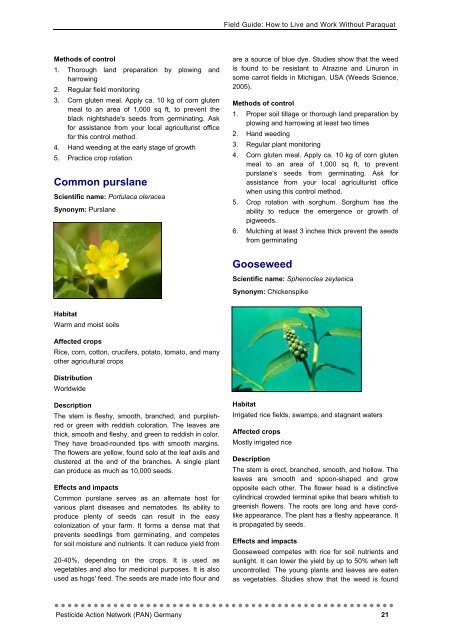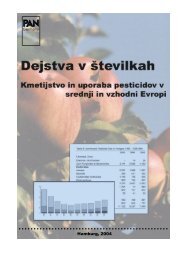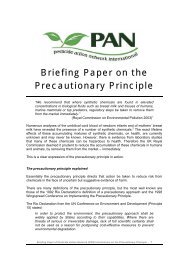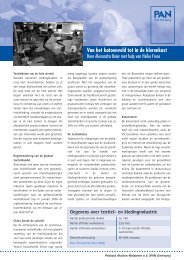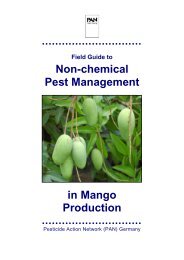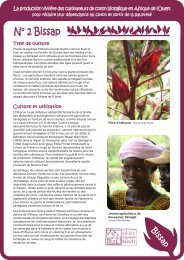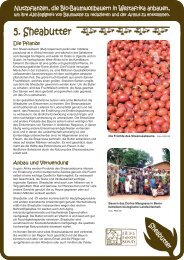Field Guide: How to Grow Crops without Paraquat - Online ...
Field Guide: How to Grow Crops without Paraquat - Online ...
Field Guide: How to Grow Crops without Paraquat - Online ...
You also want an ePaper? Increase the reach of your titles
YUMPU automatically turns print PDFs into web optimized ePapers that Google loves.
<strong>Field</strong> <strong>Guide</strong>: <strong>How</strong> <strong>to</strong> Live and Work Without <strong>Paraquat</strong><br />
Methods of control<br />
1. Thorough land preparation by plowing and<br />
harrowing<br />
2. Regular field moni<strong>to</strong>ring<br />
3. Corn gluten meal. Apply ca. 10 kg of corn gluten<br />
meal <strong>to</strong> an area of 1,000 sq ft, <strong>to</strong> prevent the<br />
black nightshade's seeds from germinating. Ask<br />
for assistance from your local agriculturist office<br />
for this control method.<br />
4. Hand weeding at the early stage of growth<br />
5. Practice crop rotation<br />
Common purslane<br />
Scientific name: Portulaca oleracea<br />
Synonym: Purslane<br />
are a source of blue dye. Studies show that the weed<br />
is found <strong>to</strong> be resistant <strong>to</strong> Atrazine and Linuron in<br />
some carrot fields in Michigan, USA (Weeds Science,<br />
2005).<br />
Methods of control<br />
1. Proper soil tillage or thorough land preparation by<br />
plowing and harrowing at least two times<br />
2. Hand weeding<br />
3. Regular plant moni<strong>to</strong>ring<br />
4. Corn gluten meal. Apply ca. 10 kg of corn gluten<br />
meal <strong>to</strong> an area of 1,000 sq ft, <strong>to</strong> prevent<br />
purslane's seeds from germinating. Ask for<br />
assistance from your local agriculturist office<br />
when using this control method.<br />
5. Crop rotation with sorghum. Sorghum has the<br />
ability <strong>to</strong> reduce the emergence or growth of<br />
pigweeds.<br />
6. Mulching at least 3 inches thick prevent the seeds<br />
from germinating<br />
Gooseweed<br />
Scientific name: Sphenoclea zeylanica<br />
Synonym: Chickenspike<br />
Habitat<br />
Warm and moist soils<br />
Affected crops<br />
Rice, corn, cot<strong>to</strong>n, crucifers, pota<strong>to</strong>, <strong>to</strong>ma<strong>to</strong>, and many<br />
other agricultural crops<br />
Distribution<br />
Worldwide<br />
Description<br />
The stem is fleshy, smooth, branched, and purplishred<br />
or green with reddish coloration. The leaves are<br />
thick, smooth and fleshy, and green <strong>to</strong> reddish in color.<br />
They have broad-rounded tips with smooth margins.<br />
The flowers are yellow, found solo at the leaf axils and<br />
clustered at the end of the branches. A single plant<br />
can produce as much as 10,000 seeds.<br />
Effects and impacts<br />
Common purslane serves as an alternate host for<br />
various plant diseases and nema<strong>to</strong>des. Its ability <strong>to</strong><br />
produce plenty of seeds can result in the easy<br />
colonization of your farm. It forms a dense mat that<br />
prevents seedlings from germinating, and competes<br />
for soil moisture and nutrients. It can reduce yield from<br />
20-40%, depending on the crops. It is used as<br />
vegetables and also for medicinal purposes. It is also<br />
used as hogs' feed. The seeds are made in<strong>to</strong> flour and<br />
Habitat<br />
Irrigated rice fields, swamps, and stagnant waters<br />
Affected crops<br />
Mostly irrigated rice<br />
Description<br />
The stem is erect, branched, smooth, and hollow. The<br />
leaves are smooth and spoon-shaped and grow<br />
opposite each other. The flower head is a distinctive<br />
cylindrical crowded terminal spike that bears whitish <strong>to</strong><br />
greenish flowers. The roots are long and have cordlike<br />
appearance. The plant has a fleshy appearance. It<br />
is propagated by seeds.<br />
Effects and impacts<br />
Gooseweed competes with rice for soil nutrients and<br />
sunlight. It can lower the yield by up <strong>to</strong> 50% when left<br />
uncontrolled. The young plants and leaves are eaten<br />
as vegetables. Studies show that the weed is found<br />
••••••••••••••••••••••••••••••••••••••••••••••••••••<br />
Pesticide Action Network (PAN) Germany 21


